In the world of hauling and transporting, versatility is the key to efficiency. Enter the multi-purpose utility trailer – a true game-changer for those seeking a flexible and practical solution for various tasks.
Let’s dive into the numerous advantages that come with owning a multi-purpose utility trailer and how it can revolutionize the way you handle your hauling needs


Owning a multi-purpose utility trailer is a strategic investment for those who value versatility, efficiency, and convenience in their hauling endeavors. Whether you're a homeowner, business owner, or outdoor enthusiast, the advantages of owning a multi-purpose utility trailer extend beyond mere transportation – it's about embracing a versatile tool that adapts to your ever-changing needs. Upgrade your hauling experience and unlock the potential of on-demand versatility with a multi-purpose utility trailer today.
GVWR (Gross Vehicle Weight Rating) and GAWR (Gross Axle Weight Rating) are terms used in the transportation industry to indicate weight limits for vehicles/trailers and their individual axles.
GVWR (Gross Vehicle Weight Rating):
• Definition: GVWR is the maximum weight a fully loaded trailer is rated to safely carry, including its own weight and the weight of passengers and cargo.
• Components: GVWR encompasses the entire trailer, including the chassis, body, engine, fuel, fluids, passengers, and cargo.
• Purpose: GVWR is crucial for ensuring that a trailer does not exceed its design capacity, promoting safety and preventing structural damage, brake failure, or other issues related to overloading.
GAWR (Gross Axle Weight Rating):
• Definition: GAWR is the maximum weight that an individual axle is rated to safely support.
• Components: GAWR considers the weight supported by each axle, including the weight of the tires, wheels, brakes, and any part of the trailer’s body or chassis directly supported by that axle.
• Purpose: GAWR is essential for preventing overloading on specific axles, which could lead to axle or suspension system failure, reduced braking efficiency, and other safety concerns.
Difference:
• The main difference between GVWR and GAWR is in their scope:
• GVWR applies to the entire trailer and represents the maximum weight the trailer can safely handle.
• GAWR focuses on individual axles and specifies the maximum weight each axle can support without compromising safety and performance.
Both GVWR and GAWR are crucial specifications for trailer owners and operators to understand, as exceeding these weight ratings can have serious safety implications and may result in fines or other legal consequences. Manufacturers determine these ratings based on extensive testing and engineering considerations to ensure the safe operation of the trailer under various conditions.
Knowing the Gross Vehicle Weight Rating (GVWR) is crucial for several reasons, all of which revolve around ensuring safety, compliance with regulations, and the proper functioning of a trailer. Here are key reasons why knowing GVWR is important:
• Safety: GVWR is a safety standard designed to prevent overloading, which can lead to various issues such as brake failure, suspension problems, tire blowouts, and compromised handling. Operating a trailer beyond its GVWR can significantly increase the risk of accidents and jeopardize the safety of passengers and other road users.
• Legal Compliance: Many regions have regulations that restrict the maximum weight a trailer can carry. Knowing and adhering to the GVWR is essential for legal compliance. Overloaded vehicles can incur fines and penalties, and drivers may be subject to legal consequences.
• Equipment Longevity: Exceeding the GVWR puts additional stress on various components of the trailer, including the suspension system, brakes, tires, and transmission. Over time, this can lead to accelerated wear and tear, reducing the lifespan of critical components and increasing maintenance costs.
• Manufacturer’s Warranty: Operating a trailer beyond its GVWR may void the manufacturer’s warranty. Warranty coverage is typically based on the assumption that the trailer is used within specified weight limits and under normal operating conditions. Exceeding these limits may result in warranty claims being denied.
• Fuel Efficiency: Overloaded trailers generally have reduced fuel efficiency. Knowing and adhering to the GVWR can help optimize fuel consumption and reduce operational costs.
• Insurance Implications: Operating a trailer beyond its GVWR may affect insurance coverage. In the event of an accident, insurance companies may investigate and potentially deny a claim if the trailer was overloaded, as it represents a violation of safety and legal standards.
• Road Infrastructure Protection: Overloaded trailers can cause damage to roads and bridges. Adhering to the GVWR helps protect the infrastructure and minimizes the public cost of road maintenance.
Understanding and adhering to the GVWR is crucial for promoting safety, legal compliance, and the efficient operation of a trailer. It is a key responsibility for drivers, fleet operators, and anyone involved in the transportation of goods and passengers.
Traveling with a trailer in tow means you're not just responsible for the safety of your vehicle, but also for the security of your cargo and the safety of others on the road. One of the most critical components ensuring this safety is your trailer's braking system. Over time, brakes wear down, lose effectiveness, and require replacement to maintain optimal performance. Whether you're an experienced DIY enthusiast or a first-timer ready to tackle maintenance tasks, understanding how to change trailer brakes is essential.
This comprehensive guide will walk you through every step of the process, from identifying the type of brakes your trailer uses to the tools you'll need and a step-by-step walkthrough of the replacement process. By the end, you'll be equipped with the knowledge to ensure your trailer brakes are in top condition, keeping your journeys smooth and safe.
Importance of Proper Trailer Brake Maintenance
Keeping your trailer brakes in top shape is crucial not just for your safety, but for everyone else on the road too. Well-maintained brakes mean you can stop reliably and safely, no matter the load you're hauling. Besides avoiding accidents, this also means dodging costly repairs down the line. Ignoring your brake maintenance can lead to bigger, more expensive problems, and nobody wants that.
Plus, staying on top of your brake condition keeps you on the right side of the law, as many places have strict rules about vehicle safety. In short, regular brake checks save you money, keep you legal, and, most importantly, keep you safe.
Types of Trailer Brakes
Knowing what type you've got on your trailer is key because it affects how you'll maintain them and how well they'll do their job of keeping you safe on the road. Here's a brief overview:
Drum Brakes
A traditional choice for many trailers, drum brakes work by pushing brake shoes against a spinning drum attached to the wheel. This friction slows the trailer down. They're known for their durability and cost-effectiveness but may require more frequent adjustments and maintenance to perform optimally.
Disc Brakes
These brakes function by pressing brake pads against a disc (or rotor), which is connected to the wheel, to create friction and slow the trailer. Disc brakes are praised for their superior stopping power and efficiency, especially under heavy loads or in wet conditions. They tend to have better heat dissipation, reducing the risk of brake fade during prolonged use.
Electric Brakes
Electric trailer brakes are activated by a brake controller from the towing vehicle, allowing for adjustable braking strength. This system is straightforward to install and use, offering good control over the braking process. Electric brakes are especially suitable for larger trailers, providing consistent performance and ease of integration with the tow vehicle's braking system.
Tools and Materials Needed
When it's time to replace your trailer brakes, having the right tools and materials on hand is crucial. Here’s a rundown of what you'll need to get the job done properly and safely:
1. Jack and Jack Stands
You'll need these to lift and securely support your trailer. Make sure they're rated for the weight of your trailer to ensure safety while you're working underneath.
2. Lug Wrench or Impact Wrench
These are necessary for removing the wheels to access the brakes. An impact wrench can make the job quicker, but a sturdy lug wrench will also do the trick.
3. Socket Set
A comprehensive socket set is essential for removing and securing various nuts and bolts throughout the brake replacement process.
4. Brake Cleaner
This helps clean the brake assembly and surrounding area, removing grease and grime for a cleaner work environment and better brake performance.
5. New Brake Parts
Depending on the type of brakes you're working with (drum, disc, or electric), you'll need new brake shoes or pads, and possibly new drums or rotors. Make sure you have the correct parts for your specific trailer model.
6. Adjustable Wrench and Pliers
These tools are handy for adjusting components and handling parts that may be difficult to maneuver with sockets alone.
7. Torque Wrench
Essential for tightening bolts to the manufacturer's specified torque, ensuring everything is secure and safe for operation.
8. Rubber Mallet
Brake components can be a bit stubborn sometimes. A rubber mallet can help loosen parts without damaging them.
9. Safety Glasses and Gloves
Always protect your eyes and hands from dirt, debris, and chemicals during the process.
10. Brake Adjustment Tool (for drum brakes)
If you're working with drum brakes, this specialized tool helps adjust the tension on the brake shoes.
Performing a Brake Controller Inspection
The brake controller is a big deal when it comes to towing safely, making sure your trailer stops when you do, smoothly and safely. So, how do you make sure this essential piece of your towing setup is always ready for action? Let's walk through checking your brake controller, ensuring every journey is as safe as the last.
1. Visual Inspection
Start with a basic visual check. Look for any obvious signs of wear or damage to the controller itself, the wiring, and connections. Make sure everything is securely mounted and that there are no loose or frayed wires.
2. Power Check
Next, verify that the brake controller is receiving power. Most controllers have an LED light or display that illuminates when connected properly. If there's no sign of power, check your vehicle's fuse box for a blown fuse or bad connection.
3. Adjustment Settings
Review the settings on your brake controller. Different loads and driving conditions may require adjustments to ensure optimal braking performance. Refer to the manufacturer's guidelines for setting adjustments based on your specific towing situation.
4. Test the Controller
The best way to test the brake controller is with a test drive. Find a safe, traffic-free area to perform this test. As you drive, apply the brakes to see how the trailer responds. The trailer should slow down smoothly without jerking. If the braking feels too aggressive or too weak, adjust the controller settings accordingly.
5. Check for Responsiveness
During the test drive, also pay attention to how responsive the brakes are. There should be no delay from the moment you apply the brakes in the towing vehicle to when the trailer begins to slow down. Any lag could indicate a problem with the controller or its connection to the trailer.
Why is an inspection important?
A properly functioning brake controller is essential for safe towing. It ensures that your trailer brakes at the same time and with the same intensity as your towing vehicle, preventing dangerous situations like jackknifing or losing control. Regular inspections and adjustments to your brake controller can significantly improve your towing experience, making it safer for you, your cargo, and others on the road.
How to Replace Trailer Brakes: Step-By-Step Guide
Tackling the job of replacing your trailer brakes might seem daunting, but with the right tools and a bit of know-how, it's a task you can take on to ensure your trailer remains a safe and reliable companion on the road. Here's a straightforward, step-by-step guide to walk you through the process, making sure you get it right from start to finish.
Step 1: Lift and Secure the Trailer
First things first, you need to safely lift the trailer high enough so that the wheels are off the ground. Use a reliable jack for lifting and then place jack stands under the trailer frame to keep it securely elevated throughout the process. Safety is key, so double-check that everything is stable before moving on.
Step 2: Remove the Wheels
With the trailer securely lifted, remove the wheels to access the brakes. Use a lug wrench or an impact wrench to loosen and remove the lug nuts, then pull the wheels off. Keep the lug nuts in a safe place so you don't lose them.
Step 3: Expose the Inner Brake Drum
Now, you'll need to remove the hubcap (if present) and any other components blocking access to the brake drum. This might include cotter pins and retaining nuts. Once these are removed, you can pull the drum off, exposing the brake components inside.
Step 4: Inspect the Brake Drum Assembly
Before you proceed with replacing anything, take a moment to inspect the brake drum assembly. Look for signs of wear, such as deep grooves or scoring on the drum surface. This is a good time to decide whether the drum needs replacing or if it can be resurfaced.
Step 5: Remove and Replace Brake Components
Carefully remove the old brake shoes (or pads, if you're working with disc brakes), springs, and any other worn components. Compare the old parts with the new ones to ensure a correct match, then install the new components, making sure everything is positioned correctly and securely.
Step 6: Reassemble and Adjust Brakes
Once the new brake components are in place, reattach the brake drum or disc. Then, adjust the brakes according to the manufacturer's instructions. For drum brakes, this usually means adjusting the tension so the brake shoes are close to the drum but not dragging.
Step 7: Test the New Brakes
After reassembling everything, it's crucial to test the new brakes to ensure they're working correctly. Lower the trailer and reattach the wheels. Tighten the lug nuts securely. Then, take the trailer for a slow test drive in a safe area, applying the brakes to check for proper function. Listen for any unusual noises and feel for any vibrations that could indicate a problem.
Replacing your trailer brakes is a hands-on way to maintain your trailer's safety and performance. While it might take a bit of effort, the peace of mind knowing you've done the job right is well worth it. Remember, if you're ever unsure about any step of the process, consulting a professional is always a smart move.
Tips for Maintaining Trailer Brakes
Maintaining your trailer brakes is key to ensuring your safety and prolonging the life of your trailer. Here are some practical tips to keep them in top shape:
1. Regular Inspections
Make it a habit to inspect your brakes regularly. Look for wear and tear on brake pads, drums, and rotors, and check for any signs of rust or damage.
2. Keep Them Clean
Use a quality brake cleaner to remove dirt, grime, and grease from the brake assembly. This helps maintain optimal braking performance and prevents buildup that can cause damage.
3. Adjust When Necessary
Especially for drum brakes, ensure they are properly adjusted. Over time, brakes can become too loose or too tight, affecting performance.
4. Monitor Brake Fluid
Check the brake fluid levels periodically and top up if needed. Also, replace the brake fluid according to the manufacturer's recommendations to prevent moisture buildup, which can lead to brake failure.
5. Check for Leaks
Regularly inspect the brake lines and couplings for leaks. Even a small leak can lead to a loss of hydraulic pressure, making your brakes less effective.
6. Listen for Noises
Pay attention to any unusual sounds when braking, such as squealing or grinding. These noises can be early warning signs of brake wear or damage.
7. Feel for Changes
Be aware of any changes in the braking performance, such as the trailer pulling to one side when braking or the brake pedal feeling spongy. These could indicate problems that need immediate attention.
8. Replace Worn Parts Promptly
Don't delay replacing worn or damaged brake parts. Using worn brakes not only puts you at risk but can also cause further damage to your braking system.
9. Use High-Quality Replacement Parts
When replacing brake components, opt for high-quality parts that meet or exceed OEM specifications. This ensures reliability and longevity of your braking system.
10. Seek Professional Help When Needed
If you're ever unsure about the condition of your brakes or how to perform maintenance, don't hesitate to consult with a professional. It's better to be safe than sorry.
Keeping Safe on the Road
Looking after your trailer brakes is your ticket to safe travels, no matter where you're headed. Whether you're pulling a load for work, heading out on a weekend adventure, or anything in between, making sure your trailer's brakes are in good shape is crucial for keeping things safe on the road. That's why it's also so important to not skimp on quality when you're picking out new brake parts. Get parts only from trusted dealers like Norstar Company. Known for their top-notch trailer parts and accessories, Norstar is the go-to for reliable brake components that you can trust to do the job right.
Taking care of your trailer's brakes by sticking to a regular maintenance schedule and choosing quality parts, like those from Norstar Company, means you're all set for smooth and safe journeys ahead.
Repacking the wheel bearings on your utility or boat trailer is quick and easy, and you'll avoid the breakdown that'll leave you stranded along the road. How many trailers have you seen on the side of the road this year with one wheel propped up? Don't let it happen to you. If you haven't checked your wheel bearings lately, read this article. You can complete this simple task in about an hour and save yourself a big repair bill.
Many trailer manufacturers recommend this maintenance every year if your trailer gets normal use, or at least every 20,000 miles. To do this job, you’ll need a jack, a pair of jack stands, a large flat-head screwdriver, a hammer and a needle-nose pliers, clean rags, a small pan, about a quart of kerosene and a spray can of brake cleaner.
First, loosen the lug nuts on one wheel and raise the side of the trailer with a jack. Support the trailer with jack stands and then spin the wheel and listen to the trailer bearings. If the wheel spins freely and quietly, proceed with repacking the bearings. If you hear friction or a growling sound, you most likely have a bad bearing or spindle. If this is the case, take the trailer to a service center to get the trailer bearings replaced.

Step 1
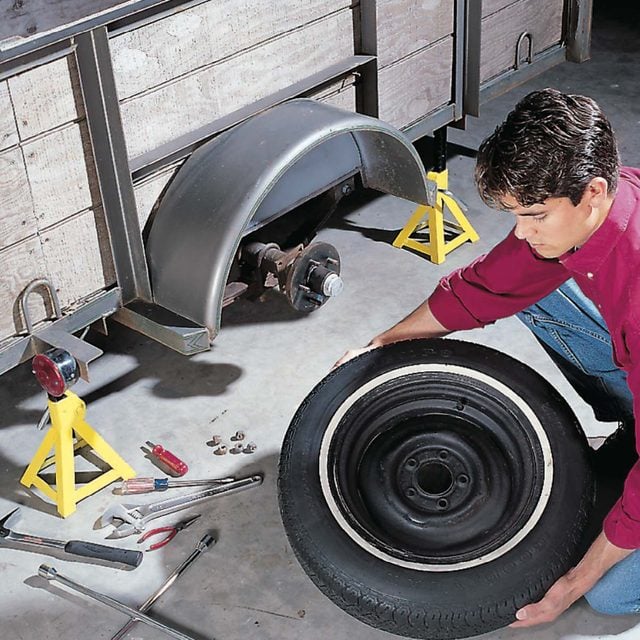
Remove the lug nuts and the wheel. Be sure that the trailer is supported with jack stands and the opposite wheel is blocked.
Step 2
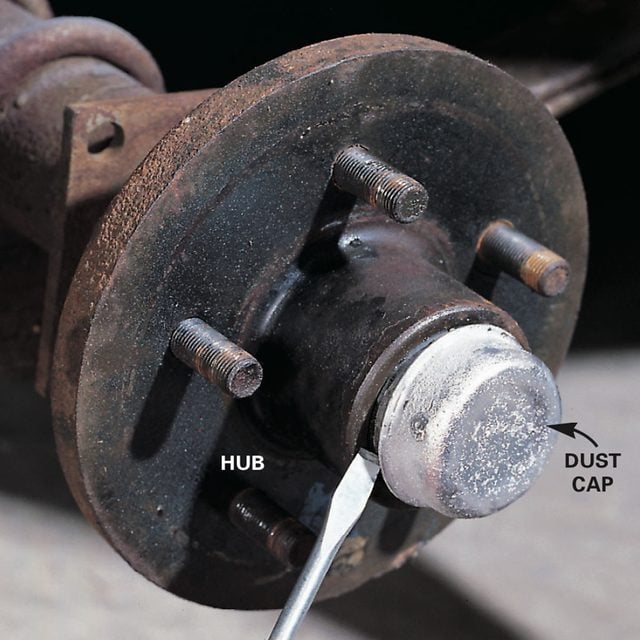
Pry the dust cap loose with a large screwdriver.
Step 3
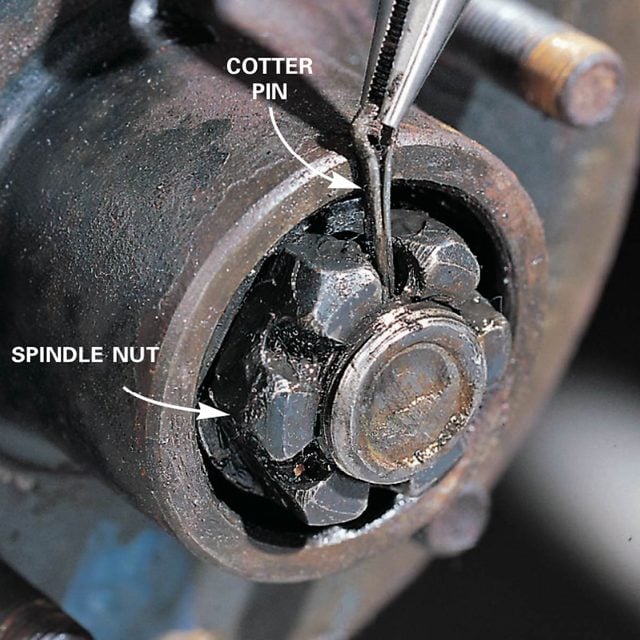
Straighten the ends of the cotter pin and pull it out with needlenose pliers.
Step 4

Remove the retaining nut and washer, then pull the hub off the spindle. Be careful—the trailer bearings will come out with the hub. Set the bearings on clean newspaper.
Step 5
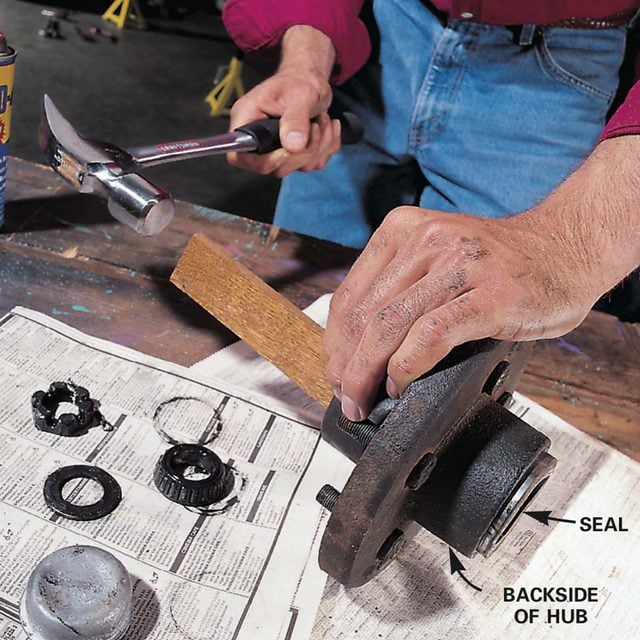
To remove the rear bearing and seal, tap along the rim of the bearing with a block of wood and a hammer. If the seal is rusted to the back of the hub, spray a little WD-40 on the back to help loosen it. If the seal is damaged, replace it. Clean all the grease from the bearings, races and seal with a brush in a small pan of kerosene. Inspect them for signs of wear and replace them if they look suspect. Once the bearings and parts are clean, spray them with brake cleaner and set them aside to dry. Wipe the spindle and the inside of the hub with a clean rag to remove all the grease, and clean them with brake cleaner as well.
Step 6
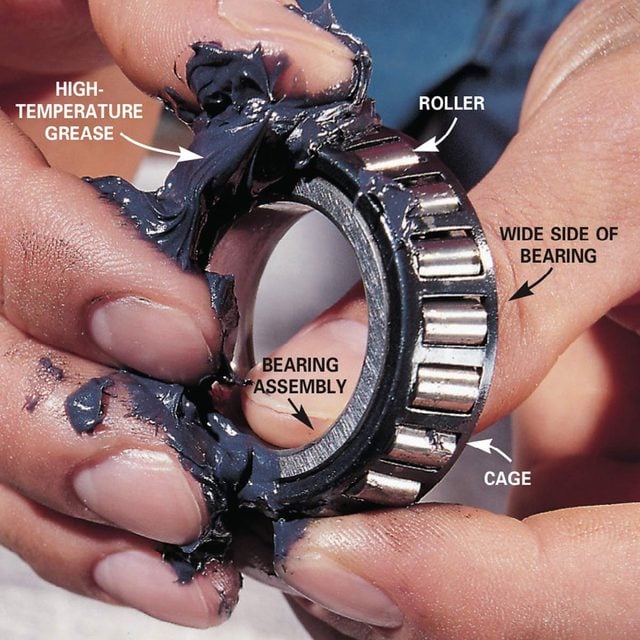
Push the grease into the bearings, working from the wide side of the bearing. Keep pushing the grease into the roller until the cage and rollers are filled. Next coat the inside of the hub with grease. Tap the seal back onto the rear of the hub with a block of wood and hammer, and install the hub and bearings back on the spindle.
Step 7
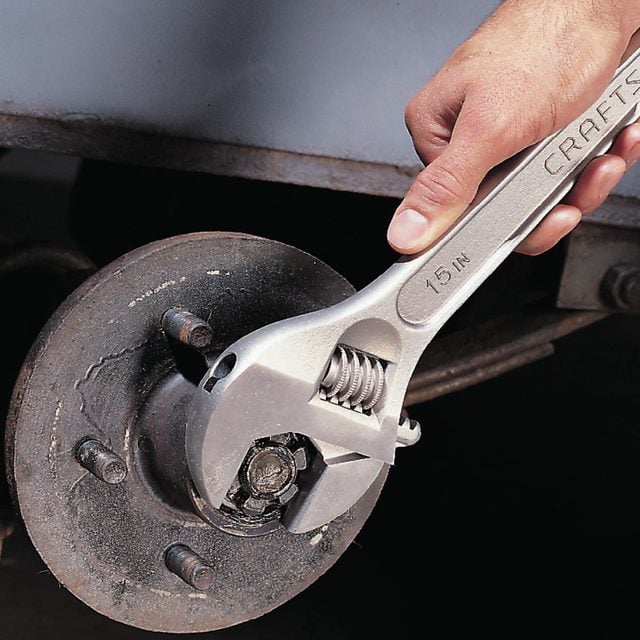
Thread the nut back onto the spindle and turn it clockwise. Spin the hub a few times as you tighten to make sure the bearings are seating properly. Tighten the nut firmly. Now back the nut off about an eighth of a turn until the hole in the spindle aligns with a space in the nut. Push in a new cotter pin (available at hardware and auto parts stores) and bend the ends of the pin to keep it from working its way out. Tap the dust cap back into place. Coat the lug threads with anti-seize compound, reinstall the wheel and tighten the lug nuts. Do the same for each wheel.
Bumper Pull vs. Gooseneck Trailers: How to Choose the Right One
When it comes to hauling, choosing the right trailer is crucial for safety, efficiency, and convenience. Two common options are bumper pull and gooseneck trailers. Each has its own advantages and disadvantages, depending on your specific needs. Here’s a breakdown to help you decide which one is right for you.
What is a Bumper Pull Trailer?
A bumper pull trailer, also known as a tag-along trailer, is hitched to a standard receiver hitch at the back of a towing vehicle. These trailers are common for smaller loads and are widely used for recreational and light commercial purposes.
Pros of Bumper Pull Trailers:
Cons of Bumper Pull Trailers:
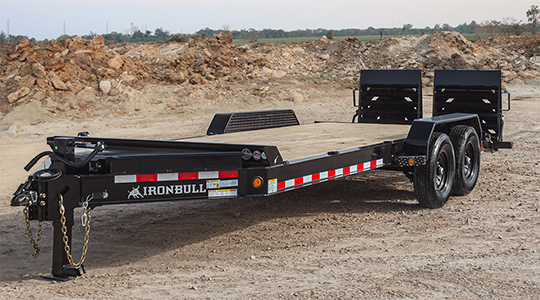
What is a Gooseneck Trailer?
A gooseneck trailer connects to a hitch inside the bed of a pickup truck. This type of hitch provides a more stable and secure connection, allowing for greater control and higher weight capacities.
Pros of Gooseneck Trailers:
Cons of Gooseneck Trailers:

Which One Should You Choose?
The best trailer for you depends on your towing needs:
Both trailer types have their own strengths, so consider your towing requirements, vehicle capabilities, and budget before making a decision. Ensuring you choose the right trailer will make your hauling experience safer and more efficient!
Trailer Safety: Essential Tips to Keep You and Your Cargo Secure
Whether you’re hauling equipment, vehicles, or supplies, trailer safety should always be a top priority. Proper preparation and awareness can prevent accidents, protect your cargo, and ensure a smooth journey every time.
1. Inspect Your Trailer Before Every Trip
Check the tires for proper inflation and wear, ensure the lights and signals are working, and inspect the hitch and safety chains. A quick inspection can catch issues before they become dangerous problems.
2. Load Your Trailer Correctly
Distribute weight evenly, keeping about 60% of the load if front of the axles. Avoid overloading, as this can cause sway or strain your vehicle’s towing capacity. Secure your cargo tightly with straps or chains to prevent shifting.
3. Drive Safely and Responsibly
Towing a trailer requires more caution. Allow extra distance for braking, take turns slowly, and avoid sudden maneuvers. Stay aware of your trailer’s length and width, especially when changing lanes or backing up.
4. Maintain Your Trailer Regularly
Routine maintenance, including checking brakes, bearings, and suspension, will keep your trailer in optimal condition and reduce the risk of breakdowns or accidents.
5. Know Your Limits
Make sure your vehicle and trailer combination complies with weight limits and towing capacity. Overloading or improper connections can lead to serious safety hazards.
By following these trailer safety tips, you’ll protect yourself, your cargo, and others on the road. Remember, a safe haul is a successful haul!

In the world of hauling and transporting, versatility is the key to efficiency. Enter the multi-purpose utility trailer – a true game-changer for those seeking a flexible and practical solution for various tasks.
Let’s dive into the numerous advantages that come with owning a multi-purpose utility trailer and how it can revolutionize the way you handle your hauling needs


Owning a multi-purpose utility trailer is a strategic investment for those who value versatility, efficiency, and convenience in their hauling endeavors. Whether you're a homeowner, business owner, or outdoor enthusiast, the advantages of owning a multi-purpose utility trailer extend beyond mere transportation – it's about embracing a versatile tool that adapts to your ever-changing needs. Upgrade your hauling experience and unlock the potential of on-demand versatility with a multi-purpose utility trailer today.
The waste management industry is booming, and one of the most lucrative areas to tap into is roll-off dumpster rentals. Whether it's for construction debris, home cleanouts, or special events, dumpsters are essential for businesses and homeowners alike. If you're looking to start your own profitable roll-off dumpster business, one of the best ways to do so is by utilizing a durable, reliable trailer like the Ironbull DBG. Here’s how you can get started and make your business a success.
Before diving into the dumpster rental business, it’s important to understand the local demand. Research the construction, renovation, and demolition trends in your area, and analyze the competition. Are there gaps in the market that you can fill? Are there enough businesses and residential customers that need dumpsters regularly?
Understanding these factors will help you determine how many dumpsters you'll need to purchase and what types of customers you should target such as:
Starting any business requires a clear legal structure. Whether you choose to set up an LLC, sole proprietorship, or corporation, make sure to:
This will ensure you're operating legally and can take steps toward scaling your business.
Step 3: Choose the Right Roll-Off Dumpster Equipment
When it comes to roll-off dumpsters, quality equipment is crucial. This is where the Ironbull DBG comes in. Ironbull trailers are known for their superior build quality, rugged durability, and versatility. The Ironbull DBG model is a particularly excellent choice for roll-off dumpster businesses. Here's why:
1. Exceptional Durability and Build Quality
The Ironbull DBG is built with heavy-duty steel construction, providing the strength and reliability necessary to handle tough hauling jobs. Whether you're dealing with construction debris, gravel, or scrap metal, this trailer can withstand the wear and tear of daily use. The durability ensures long-lasting performance, making it a cost-effective investment for consumers.
2. Option of Gooseneck or Bumper Pull Design
When comparing a bumper pull dump trailer to a gooseneck dump trailer, each offers unique advantages based on your needs. The bumper pull is more maneuverable, making it easier to hitch, unhitch, and tow in tighter spaces. It’s also compatible with most standard vehicles and is ideal for lighter to moderate loads, offering convenience for everyday tasks and short hauls. On the other hand, the gooseneck provides greater stability and control, particularly over rough terrain or at higher speeds, thanks to its connection over the rear axle of the truck. With a higher towing capacity, it’s perfect for heavier loads and longer hauls, though it requires a vehicle equipped with a gooseneck hitch.
3. Versatility for Multiple Uses
Ironbull DBG trailers are highly versatile, making them suitable for a wide range of applications. Whether you need it for transporting construction materials, hauling debris, or handling waste management tasks, this trailer adapts easily to various needs. This makes it a great choice for contractors, landscapers, and waste management companies alike.
4. Ease of Loading and Unloading
The DBG trailer is designed to make loading and unloading as efficient as possible. With hydraulic lifting capabilities, the trailer's dump body can be raised to release materials quickly and effortlessly. This feature saves consumers time and labor costs, allowing them to complete jobs more efficiently and with less manual effort.
5. Heavy Payload Capacity
Ironbull DBG trailers come with impressive payload capacities. They are built to haul large amounts of material, such as debris, dirt, or scrap, making them ideal for construction projects or other heavy-duty tasks. With a higher payload capacity, consumers can take on bigger and more profitable projects without worrying about overloading their equipment.
In conclusion, investing in a roll off dump trailer can have the potential to greatly enhance your business. By considering the factors outlined in this guide and choosing a reputable manufacturer and dealer, you can ensure a wise and efficient purchase.
Norstar Company is a renowned industry leader in providing top-tier roll off dump trailers, known for their exceptional quality and durability. Explore their best roll-off dump trailers and revolutionize your hauling operations today! Build and quote here.